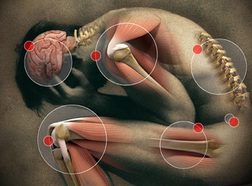How Is Pain Treated
You’ve got a number of pain-relief options -- some more effective than others, some offering distraction rather than pain relief. Contact us we have providers willing to help!
Spine Pain and Treatments
If you have painful compression fractures in the spine, both surgical and nonsurgical treatments are explored. We make surgery your last option.
Pain in the back or neck can be caused by a group of nerves, joints, facets, ligaments or muscles. When more conservative methods of pain control and diagnosis are ineffective, specialized procedures may be indicated.
One such procedure to treat refractory back or neck pain is the median branch block. This block can be performed in the cervical, or lumbar areas of the spine, depending upon the site of pain or pathology. Injecting medications into these nerves may decrease the pain due to facet joint pathology, as well as for certain problems stemming from ligament or bursa trauma. This type of nerve block assists in the diagnosis of a pain problem, and helps the physician in the decision process as to proper course of more permanent therapy.
The medial branch block is performed with the assistance of a special x-ray machine (fluoroscopy) which enables the physician to accurately locate the nerve sites for the best therapy possible.
Trigger Point Injections
Medical specialists such as an orthopedist, pain specialist, or neurologist can administer TPI. Injections are given in the physician's office and takes approximately 30 minutes. Before performing TPI, the physician may give the patient a nerve block to prevent pain from needle penetration. A small needle is inserted into the trigger point and a local anesthetic (e.g., lidocaine) with or without a corticosteroid is injected. Injection of medication inactivates the trigger point and thus alleviates pain. Sustained relief usually is achieved with a brief course of treatment. The injection may cause a twitch or pain that lasts a few seconds to a few minutes. Numbness from the anesthetic may last about an hour and a bruise may form at the injection site. Pain can be relieved by alternately applying moist heat and ice for a day or two. In most cases, stretching exercises and physical therapy are performed following TPI.
Supartz Knee Injections
When you have knee osteoarthritis, the hyaluronic acid (HA) in the synovial fluid in your knee joint becomes diluted and breaks down—reducing its natural properties. This is associated with increased inflammatory processes that can degrade the cartilage in your knee.
This inflammation causes pain receptors to begin firing during normal movement.1 The pain tends to cause knee osteoarthritis patients to limit movement, which in turn leads to further deterioration of joint structures and synovial fluid quality because movement is required for normal synovial homeostasis. This process can become a vicious cycle as the disease becomes progressively worse and quality of life is severely compromised for patients.
Breaking the vicious cycle SUPARTZ Joint Fluid Therapy treats knee osteoarthritis by providing temporary replacement for the diseased synovial fluid in your knee, which is an underlying cause of your pain. b Unlike oral analgesics or non-steroidal anti-inflammatory drugs (NSAIDs) that affect all parts of your body, SUPARTZ specifically targets the osteoarthritis in your knee.
Spinal Cord Stimulation
Low-level electrical signals can block pain signals from reaching the brain. A spinal cord stimulator is a device used to exert pulsed electrical signals to the spinal cord to control chronic pain. Spinal cord stimulation (SCS), in the simplest form, consists of stimulating electrodes, implanted in the epidural space, an electrical pulse generator, implanted in the lower abdominal area or gluteal region, conducting wires connecting the electrodes to the generator, and the generator remote control. SCS has notable analgesic properties and, at the present, is used mostly in the treatment of failed back surgery syndrome, complex regional pain syndrome and refractory pain due to ischemia.
TENS (Electrothermal Therapy)
If you need short-term pain relief, TENS might help.
Transcutaneous electrical nerve stimulation (acronym TENS) is the use of electric current produced by a device to stimulate the nerves for therapeutic purposes. TENS by definition covers the complete range of transcutaneously applied currents used for nerve excitation although the term is often used with a more restrictive intent, namely to describe the kind of pulses produced by portable stimulators used to treat pain. The unit is usually connected to the skin using two or more electrodes. A typical battery-operated TENS unit is able to modulate pulse width, frequency and intensity. Generally TENS is applied at high frequency (>50 Hz) with an intensity below motor contraction (sensory intensity) or low frequency (<10 Hz) with an intensity that produces motor contraction.
Chronic Pain and Lifestyle Changes
A few changes in everyday habits can help get pain under control. Modifying personal habits and lifestyle to prevent future exacerbation of the underlying cause of the pain is also important. For example, maintaining an appropriate body weight that's known not to aggravate the discs (this varies from patient to patient) as well as changing the way one goes about bending over for objects on the ground (heavy or light, it doesn't matter...all one has to do is bend in the wrong direction to invoke an episode). Another important lifestyle change that is usually recommended is to maintain a regular stretching and exercise program.
Your Pain Treatment Agreement
If you take narcotic pain relievers, your doctor may ask you to sign an agreement form.

